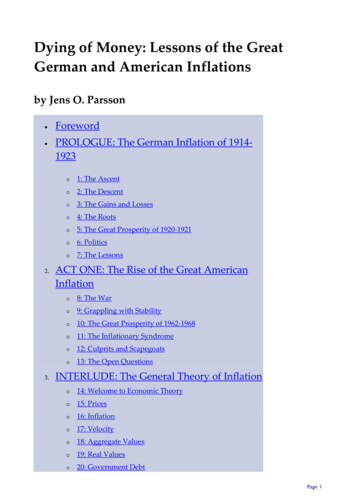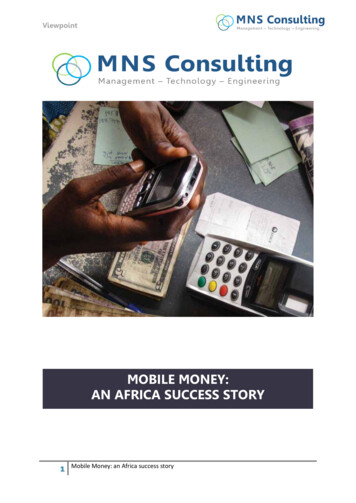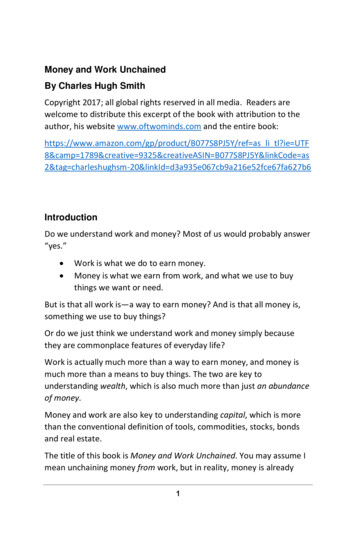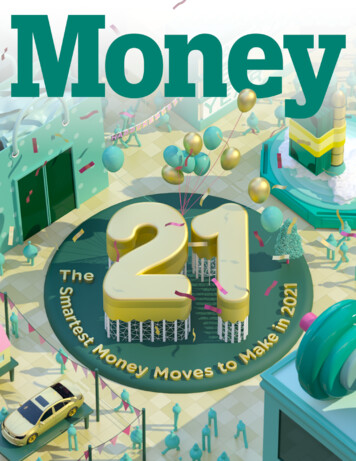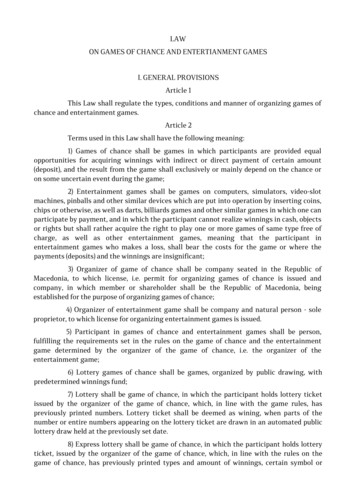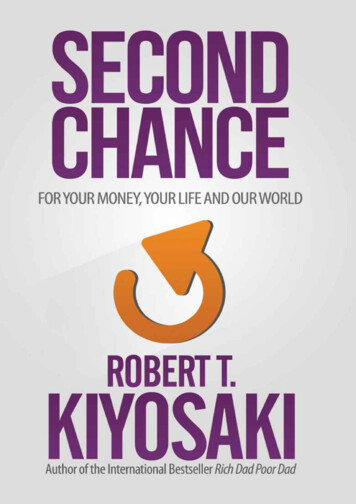
Transcription
DedicationThis book is dedicated to Dr. Richard Buckminster Fuller,1895-1983.Dr. Fuller is a man who is almost impossible to describe or putinto a category. He is referred to as a futurist, an inventor, ateacher, a philosopher, and an architect. Twice he was admittedto Harvard University and twice he was asked to leave.He has numerous doctorate degrees, U.S. patents, awards andhonors, including the Gold Medal from the American Instituteof Architects and the Presidential Medal of Freedom fromPresident Ronald Reagan.
Bucky Fuller is most recognized for his work on the GeodesicDome, a structure used today all around the world. DisneyWorld’s Epcot Center features one of Fuller’s domes. He hasbeen called the first futurist, a man who turned predicting thefuture into a science. Many of his predictions have come true,and many are coming true today.Most loved for his humanity, Dr. Fuller is often called “ThePlanet’s Friendly Genius” and “Grandfather of the Future.” In1982 John Denver wrote and recorded the song What OneMan Can Do, a dedication to Dr. Fuller.Pictured above is Fuller’s geodesic dome, the U.S. Pavilion atthe 1967 World’s Fair—Expo 67—in Montreal, Canada.This book, Second Chance, begins with my trip to Expo 67. Ihitchhiked from New York to Montreal to see Fuller’s dome and to see the future.
In AppreciationA heartfelt thank you to Mike Sullivan, CEO of The Rich DadCompany, and Shane Caniglia, President of The Rich DadCompany, for cleaning up the past and taking Rich Dad into thefuture.And for giving The Rich Dad Company its Second Chance.A special “thank you” to the team at Rich Dad for supportingMike and Shane through times that tested our souls.The Rich Dad TeamKathy Grady—2000Mona Gambetta—2001Bob Turner—2002Christina Ingemansdotter—2004
Greg Arthur—2006Mike Allen—2007Brett Bottesch—2008Ryan Nalepinski—2008Mike Sullivan—2009Shane Caniglia—2009Robert Boorman—2009Robb LeCount—2009Brad Kendall—2009David Leong—2009Rhonda Hitchcock—2009Idalia Fuentes—2010Darrin Moore—2010Jack Koch—2011Zeke Contreras—2011David Adams—2012Derek Harju—2012Matthew Stein—2012Tony Femino—2012Melissa Marler—2012Josh Nesa—2014Matt Quirk—2014
Author’s NotesAlthough this book references government and politics, it doesnot have a political agenda. The author is not a Republican ora Democrat. If anything, he is an Independent.This book mentions god and spirit. This is not a religiousbook. It has no religious agenda. The author believes in thefreedom of religion, the freedom to believe—or not believe—in god.“We are called to be architects of the future, not its victims.” –R. Buckminster Fuller
IntroductionOnce Upon a Time America was the richest creditor nationin the world.Once Upon a Time The U.S. dollar was backed by gold.Once Upon a Time Printing money was a crime known ascounterfeiting.Once Upon a Time A person went to school, got a job,retired young, and lived happily ever after.Once Upon a Time All you had to do was buy a house, andwhen your house went up in value you were rich.Once Upon a Time All you had to do was invest in thestock market, and when the stock market went up you wererich.Once Upon a Time A college degree meant higher pay.Once Upon a Time Age was an asset.Once Upon a Time A retired person could count on SocialSecurity and Medicare to take care of them.Unfortunately, Once Upon a Time is over. The fairy tale hasended. The world has changed and continues to change.Q: So what does a person do now?A: That’s what this book is about. This book is about a secondchance for you, your money, and your life.This book has three parts: the Past, thePresent, and the Future.The Past examines the real causes of the financial crisiswe’re facing.The Present analyzes where you are today.The Future explores your second chance for your moneyand your life and how you can use the opportunities that arefound in crisis and adversity to create the life you want.
The most important word today is crisis. Remember that thereare two parts, two sides, to the word crisis: danger andopportunity.Your second chance requires that you avoid the dangers thatlie ahead and be prepared for the opportunities that exist in agrowing, global financial crisis.
Part One: The PastIntroductionI was in a Starbucks the other day and ran into a friend I hadnot seen in years. Although happy to see him, I was surprisedto find him working behind the counter.“How long have you worked here?” I asked.“About five months,” he replied as he took my order.“What happened?” I asked.“Well, after the market crashed in 2007, I lost my job. I foundanother one, but that job soon disappeared, too. Finally, afterburning through our retirement and savings, we lost our house.
We just couldn’t hang on.” He continued: “Don’t worry.We’ve been working. We’re not unemployed. We both havejobs, but we’re not making much money. So I work here, atStarbucks, to make a few bucks. Get it, I work for bucks atStarbucks?” He said, laughing out loud.Stepping aside so the customers behind me could place theirorders, I asked, “So what are you doing for your future?”“I’m back in school. I’m getting another Masters degree. It’skind of fun being in school again. I even take a few classeswith my son. He’s earning his first Masters degree.”“Paid for with student loans?” I asked.“Yeah. What else can we do? I know they’re terrible loans. Iknow I’ll be working for the rest of my life, just to pay off myloan. My son has more time to pay off his. But we all needmore education if we want high-paying jobs. We have to makemoney. We need to earn a living. So we’re in school.”I paid for my coffee and was handed a steaming cup. When Ioffered him a tip, he refused and I know why he refused. SoI wished him luck, and walked out the door.Part One of this book is about the past. More specifically, howwe got into this global financial crisis.As George Orwell wrote in his book 1984,“In a time of universal deceit, telling the truth is arevolutionary act.”
Chapter OneWhy The Rich Don’t Work For Money“They’re playing games with money Our wealth is stolen viathe money we work for.” – R. Buckminster FullerRich Dad Poor Dad was self-published in 1997. It had to be aself-published book because every major publisher we pitchedit to turned it down. A few publishers commented, “You don’tknow what you are talking about.”Some of the points they objected to were my rich dad’sstatements such as:1. Your house is not an asset.2. Savers are losers.3. The rich don’t work for money.Ten years later, in 2007, the subprime mortgage crisis hit andmillions of homeowners found out—first hand—that theirhouse is not an asset.In 2008, the U.S. government and Federal Reserve Bankbegan printing trillions of dollars, causing millions of savers tobe losers via the loss of purchasing power due to inflation,higher taxes, and low interest rates on their savings.Rich Dad’s Lesson One in Rich Dad Poor Dad is The RichDon’t Work for Money and it was the least criticized of richdad’s three teachings on money. In this chapter, you will learnwhy this comment is the most important of my rich dad’slessons, and why it is important to understand before youconsider your opportunities for a second chance, a fresh startfor both your money and your life.What You Need to Know About Money
The subject of money can be complicated and intimidating.But if you start with the basics and use them as buildingblocks you can gain the knowledge you need to understandmoney and investing and how to make your money work foryou.The most basic thing you need to know about money is that itis a subject that you can become smarter about, a subject thatcan give you the confidence to make informed and educateddecisions.Q: Who needs a second chance?A: We all do.Q: Why?A: Because money—as we know it—has changed andcontinues to change.Q: Why is that important?A: Because the poor will become poorer, the middle class willshrink, and the rich will get richer.Q: I think we all know that. What is different about the richgetting richer and everyone else becoming poorer?A: Many people who are rich today will be among the newpoor.Q: Why will the rich become the new poor?A: There are many reasons. One reason is because many richpeople measure their wealth in money.Q: What’s wrong with that?A: The fact that money is no longer money.Q: If money is no longer money, then what is money?A: Knowledge is the new money.Q: So if money is knowledge, you’re saying that many who arepoor and middle class today, have the opportunity to becomethe new rich of tomorrow?A: Exactly. In the past, the rich were those who controlled landand resources such as oil, weapons, or giant corporations.
Today things are different. Today we live in the InformationAge—and information is abundant and often free.Q: So why isn’t everyone rich?A: It takes education to process information into knowledge.Without financial education, people cannot processinformation into personal wealth.Q: But America spends billions on education. Why are theremore poor people than rich people?A: Hundreds of billions of dollars are spent on education, butalmost nothing is spent on financial education.Q: Why isn’t financial education taught in schools?A: I have been asking that question for years, ever since I wasnine years old.Q: And what did you find out?A: I learned that knowledge is power. If you want to controlpeople’s lives, limit their knowledge. That is why, throughouthistory, despots have burned books and exiled (and evenkilled) those with knowledge who threatened their power.Before the Civil War in America, it was against the law inmany states to teach slaves to read and write. Knowledge isthe most powerful force on earth. That is why the control ofknowledge is essential to the control of power.The formula is:Information x Education KnowledgeKnowledge is power—and lack of knowledge is weakness.My poor dad was a highly educated man with a PhD, but hehad almost no financial education. He had authority within theschool system, but little power in the real world.My rich dad never finished school, but he was highly educatedin the world of money. Although less formally educated thanmy poor dad, he had more power in the real world than mypoor dad.Q: So those in power maintain control of that power throughthe school system through what’s taught—and what isn’t
taught. That’s why there is no financial education in schools?A: I believe that’s true. Today financial knowledge is morepowerful than a gun or the whips and shackles of slavery. Thelack of financial education enslaves billions of people in allparts of the world.Q: What has replaced the whips and shackles and guns?A: The monetary system.Q: The monetary system? Our money? How does the monetarysystem control people?A: The money system is designed to keep people poor, not tomake them rich. The monetary system is designed to keeppeople working hard for money. Money enslaves those whoare uneducated financially. Those who are financiallyuneducated become slaves to a paycheck.And our wealth is stolen through money, through the verything most people work for all their lives. That is why thepeople who work the hardest for money, often called the“working poor,” continue to grow poorer, not richer, no matterhow hard they work.Q: How is our wealth stolen via our money?A: There are many ways. You may already know some ofthem.They are:1. TaxesThe value of your labor is stolen via taxes.2. InflationPrices rise when governments print money. Asprices rise, people work harder, only to pay more intaxes and inflation.3. SavingsThe banks steal savers’ wealth via a banking processknown as the fractional reserve system. Let’s use afractional reserve of 10, as an example. A saver puts 1 into his or her savings account. The bank is
allowed to lend 10, against that 1, to borrowers.This is another form of “printing money” which isnot only inflationary but reduces the purchasingpower of a saver’s money. This is one of a numberof reasons why rich dad often said, “Savers arelosers.”Later in this book I will explain other ways in which yourmoney is stolen from you. As I’ve said: The monetary systemwas designed to make people poorer, not richer.Q: Can you prove that?A: I will show you a graph. As the saying goes, ‘A picture isworth a thousand words.’ The graph is not proof, but it doestell a story about the growth of people needing governmentassistance.The War on PovertyIn 1964, President Lyndon Johnson declared a war on poverty.Many believe we won that war. Others do not. The chart belowshows the numbers of people who use “food stamps,” todaycalled SNAP: Supplemental Nutrition Assistance Program.Although many believe we won the war on poverty, theincreasing reliance on food stamps tells a different story.
The chart of individuals receiving food stamps shows that, in1975, approximately 17 million people received food stamps.By 2013, the number had increased to approximately 47million people and continues to increase.Q: If the number of poor people is increasing, where are theycoming from?A: The middle class. Many of today’s poor were doing well asmiddle-class Americans a few years ago.The War on the Middle Class
The chart above shows what’s happening to the middle class.A few years ago, TV journalist Lou Dobbs wrote a book onthis middle class decline, The War on the Middle Class: Howthe Government, Big Business, and Special Interest GroupsAre Waging War on the American Dream and How to FightBack. His point: If the middle class is in decline, the UnitedStates is in decline, since the middle class is the engine of theU.S. economy.During the 2012 Presidential campaign, both candidatesBarack Obama and Mitt Romney promised to save the middleclass. An inquiring mind might ask, “Why does the middleclass need saving?” As most of us know, if the government ispromising to save you, you have already lost.Inflation Steals Wealth
The monetary system steals our wealth through inflation. Thechart below explains why the poor and middle class arestruggling, regardless of how hard they work.Q: How does the monetary system cause inflation?A: The primary cause of inflation is the printing of money.When money is printed—by banks or governments—twothings happen: inflation kicks in and taxes goes up. Whenprices and taxes go up, people struggle financially.Q: How do people survive when prices go up?A: When prices go up, people use their credit cards to survive.Many are forced to cut expenses like healthier food ordental care. Many become slaves to debt. And many morebecome little more than indentured servants, or slaves to theirpaychecks.
Debt SlavesAs middle-class income declined, and taxes and prices wentup, many turned to their credit cards to survive, becomingslaves to debt.The chart below tells that story.Today, taxes, debt, and inflation are the iron shackles that bindmodern-day slaves.Two Types of RichQ: How are the rich getting richer, if the poor and middleclass are growing poorer?A: There are two types of rich people. One type of rich is thetruly rich. They are getting richer. The other type of rich isgetting poorer. The chart on the next page tells that story.
Q: I can see that the rich, the upper 1%, are getting richer. Butwhat is happening to the 90-95%? Why is their income goingdown? Are those the rich that you’re talking about, the richthat are growing poorer?A: Yes. This chart tells a tale of two different types of richpeople. As you can see from the chart, the real rich, the top 1%of all Americans, became extremely rich—with a gain of309% in income since 1979.Yet, the top 95-99% are losing ground. Their income is notgrowing.Q: Is this why you said earlier about some of the richbecoming the new poor?A: Yes. Notice the chart we just looked at only takes us to2007. That was the year the Great Recession began. After2007, many millionaires were wiped out in the subprimemortgage fiasco and the stock market crash.
Q: So this chart would look worse today?A: Yes. The upper 1% of Americans has gotten richer. Manyof the others, the other type of rich I’ve described, are nowpoorer. Many slid from rich to poor in less than a year. Manywere wiped out when they lost their high-paying jobs, theirhomes, and their wealth as stock portfolios collapsed.Of the rich who survived the crash and remain in the upper20%, many (thanks to inflation) are becoming poorer. Somehave already slid into the middle class.Q: Tell me again what’s the difference between the two typesof rich?A: One type of rich is people with high-paying jobs, such ascorporate executives, professional people such as doctors andlawyers, athletes, and movie stars. They are high-income rich.
The other type of rich is the person who does not need a job tobe rich. Most of these people are asset-rich.The Millionaire Next DoorIn 1996, The Millionaire Next Door was published. It was agreat book for its time. Written by Thomas J. Stanley andWilliam D. Danko, the book described how ordinary, middleclass citizens had become millionaires. They did it withoutbeing Donald Trump, Steve Jobs, or Gordon Gekko from themovie Wall Street. They were not millionaire movie stars, rockstars, or professional athletes. They had become middle-classmillionaires by having a good education, living in a modesthome in an upscale neighborhood, driving sensible cars,saving money, and investing steadily in the stock market.Many were “net-worth millionaires,” people who had becomerich as a result of the rising value on their homes andretirement portfolios. They had become middle-classmillionaires through inflation, by being part of the rising U.S.economy. They were living proof of the American Dream.The September 11, 2001 terrorist attacks signaled the start ofthe new millennium and end of the American Dream.The chart below shows that, since 9/11, life for the millionairenext-door has not been easy.
In 2000, the NASDAQ or dot-com crash triggered a series ofbooms and busts, shaking many millionaires-next-door out ofthe millionaire category.The Foreclosure Next DoorIn 2007, when the subprime-mortgage bubble burst, manymillionaires-next-door became the foreclosure-next-door.
Prior to 2007, housing prices had been rising steadily foryears. As home prices rose, millions of homeowners begantaking out “home-equity loans,” which many used to pay offcredit card debt or go on vacation. Using their homes asATMs they learned the hard way—when they were upsidedown—that their “house is not an asset.”When housing prices crashed, credit card use went down.When homeowners stopped using their credit cards, theeconomy slowed because the economy depends uponconsumer spending and use of their credit cards. Whenconsumers slowed their spending, retailers began to suffer, andwhen retailers suffer the world economy suffers.Today, in 2014, there are approximately 115 millionhouseholds in the United States. Of those 115 millionhouseholds, 43 million are renters and 25 million are
households or families who own their homes free and clear. Ofthe approximately 50 million households with mortgages, it’sestimated that over 24 million are “underwater,” which meansthey owe more on their home than their home is worth.As long as homeowners feel poor, the economy will suffer.The Lost GenerationWhen the middle-class millionaires-next-door lost their jobsand their homes, and began using retirement accounts to paythe bills, there was another casualty: The children of themillionaire-next-door.All over the world, there is a generation of young peopleknown as the new lost generation. They’re the college andtrade school and high school grads who cannot find jobs orjobs that utilize their level of education. More than income,they are losing crucial real-life work experience. Without reallife work experience in their 20s and 30s, their earning powerand income in later years will suffer, which is why they’reoften called the lost generation.Young, Educated, and in DebtMany of these highly educated people graduate saddled withstudent-loan debt, quite possibly the worst of all possible debt.Unlike a car loan, home loan, or business loan, student loandebt is rarely forgiven. A student cannot declare bankruptcyand expect to be released from the loan. Student loan debt isan albatross around the neck of a student for life, accruinginterest for life. Many will have problems buying a car, home,or investing for their future until their student loan debt is paidoff. The current overhaul of the student loan programs mayaddress these issues and challenges.Many of these young people are boomerang kids, kids wholeave home, only to return to live with mom and dad. Thismakes many moms and dads, the sandwich generation, peoplewho are now caring for their kids and their parents, often withthree generations living under one roof.Other countries offer free higher education. In America, wecreate debt slaves out of our students.
Q: Is this why you say everyone needs a second chance?Because some of the rich are becoming poor, the middle classis shrinking, poverty is increasing, and our students are highlyeducated, underemployed, and deep in debt?A: Yes. The world is changing and money is changing. Thosewho are operating in the past, with the old-world rules ofmoney, are being wiped out in the present.We live in the Information Age. There is an abundance ofinformation, and much of it’s free. But without financialeducation, a person cannot convert that information intoknowledge.Q: And if knowledge is power, then millions are highlyeducated but without much power. Is that why millions ofpeople need a second chance to get their power back?A: Yes.Q: The Millionaire Next Door was published in 1996. RichDad Poor Dad was published in 1997. What was the differencebetween the two books?A: The Millionaire Next Door was about net-worthmillionaires. Rich Dad Poor Dad was about cash-flowmillionaires.Q: There’s a difference?A: A very big differences. Many net worth millionaires werecounting their liabilities, such as their home and their car, asassets. When the real estate and stock markets crashed, manynet-worth millionaires were wiped out as the value of theirliabilities crashed.Many cash-flow millionaires, millionaires who receive theirincome from real assets, got richer. They got richer buying theliabilities of the net-worth millionaires at bargain-basementprices.Q: So without financial education, millions do not understandthe difference between the different types of rich people?A: That is correct. There are many different ways a person canachieve great wealth. For example, a person can inherit wealth
or marry into wealth. As Warren Buffett often says, “There aremany ways of getting into financial heaven.”Since my poor dad was poor, a man without assets, I had nowealth to inherit. Nor did I want to marry for money. At anearly age, I decided I would gain my wealth my rich dad’s way—via financial education and acquiring assets.Q: So without financial education, most people don’t knowthe difference between assets and liabilities. So their wealth isstolen via a lack of financial education. Is that what you’resaying?A: Yes. If a person knew the simple definitions of basicfinancial words, their wealth would increase. The good news isthat words are free.Past, Present, and FutureQ: And that is why millions of educated, hard-working peopleare losing their wealth? They have become educated slaves tomoney, much like the uneducated slaves before the Civil War.Is that what you are saying?A: Yes. Education—or the lack of education—is one of thekeys on the key ring of those in power.Q: What is happening to those in power?A: The Information Age is causing those in power to losepower. That’s why your personal financial education is moreimportant today than at any other time in history. Desperatepeople in power are doing desperate things to hold on to theirillusion of power.Q: What do you see in the future?A: Once again, pictures are more powerful than words. I willshow you a few pictures, add a few words, and let you decidewhat the future holds.
On this one chart, you are looking at the past, present, andfuture of the Dow Jones Industrial Average. It is not a measureof the whole economy, but it is a snapshot of what has beengoing on in one part of a complex economy.Q: So there are three choices for the future: up, down, orsideways?A: Yes. The choices are always the same.Q: What do you see for the future?A: The best way to see the future is to look at the past. In thechart we just looked at you can see the past and an eventknown as the Great Depression, an event marked by the stockmarket crash of 1929.
Q: That was the giant stock market crash of 1929?A: Yes.Q: Could a next crash be bigger?A: Yes.Q: What would happen if the next crash were bigger?A: Look at the Great Depression.
The Great Depression, when measured against the Dow, lasted25 years, from 1929 to 1954. In 1929, the Dow hit an all-timehigh of 381. It took 25 years for it to reach 381 again. This isan alternative point of view, as there are those who believe itended in 1939.Q: Could we be entering a New Depression?A: Yes. Many people already are in their own NewDepression. That’s why food stamp use is up, the middle classis shrinking, students who are loaded with student-loan debtcan’t find jobs, and many of yesterday’s millionaires-nextdoor are broke. On top of this we have the first ofapproximately 76 million American baby boomers retiring.Many, if not most, of these aging baby boomers don’t haveenough money to retire. Advances in healthcare and medicinemay mean these baby boomers will live longer, while the cost
of healthcare is likely to continue increasing, as is the cost offood, fuel, and housing.So-So SecurityTake a look at the chart below on the condition of the UnitedStates Social Security Fund.Q: What does this chart mean?A: It means different things to different people. If you areyoung, it means you’d better not count on the government totake care of you. If you are a baby boomer, it means themoney you paid into the Social Security fund is gone. If youare of the World War II generation, your timing was good.Another interesting chart is this one on the National Debt. Ittells another story.
Q: What story does this chart tell?A: Again, it depends upon who you ask. For most people, andthe average American, it means nothing. Without financialeducation, most Americans are clueless. This chart has verylittle meaning to them.Today the national debt tops 17 trillion. To some people itmeans the end is near. And to a few, it points to theopportunity of a lifetime.Q: What does it mean to you?A: While I empathize with the first two groups, I am in thethird group. Although I’m a bit fearful and very concerned forthose who will be hurt, I view the future with excitement,excited to be a witness to the biggest power shift and transferof wealth in the history of the world. It is the dawn of a new
age. If the change is managed well, many of humanity’sshackles will be thrown off and we will enter an age ofsustainable prosperity for all. If things do not go well, andthose in power today win using violence to retain control oftheir power, we may enter a New Dark Age.Q: What will make the difference?A: Many things will play a role such as technology and therise of China as a world power. Yet the big shift must come ineducation, not only in what we teach and but how we teach.Q: What do you think the chances are? Do you think educationwill change?A: No. Not in the near future. A case could be made to supportthe position that those who control the monetary system alsocontrol the educational system. That is why I became aneducational entrepreneur back in 1984. That is why I write mybooks and create financial education games outside the schoolsystem. Today I am a hybrid, an entrepreneur like my rich dadand an educator like my poor dad.As you may know, I believe in personal responsibility. Ibelieve in changing the things we have the ability to changeand control. Each of us has the power to change ourselves.And the easiest—and often most powerful—change we canmake is through education.Q: What do you see in the future?A: To see the future you must study the past. As the sayinggoes, “Those who do not learn from the past are condemned torepeat it.”In the past, there were two different types of Depressions:1. The American Depression (1929 to 1954)2. The German Hyper-Inflation (1918 to 1924)Q: What was the difference?A: In very simple terms, Americans did not print money andthe Germans printed money.
Pictured here is what happened when Germany began printingmoney.Permission is granted to copy, distribute and/or modify thisphotograph only (and not other parts of this book) under theterms of one or more of the (1) GNU Free DocumentationLicense, Version 1.3, or any later version published by theFree Software Foundation; with no Invariant Sections, noFront-Cover Texts, and no Back-Cover Texts (a copy of thelicense can be found at www.gnu.org), and (2) CreativeCommons Attribution-Share Alike 3.0 Unported license,which can be found at https://creativecommons.org/licenses.The picture above shows what happens when a central bankand a government print money to pay their bills.In 1918, a German citizen could be a “millionaire” by havingmillions of German Reischmarks in savings. In less than five
years, that same German millionaire was poor.Q: Is the same thing happening in the United States today?A: Yes.The following is a chart on QE, Quantitative Easing.Q: What does this mean?A: It means the United States is following the German modelfrom the last Depression. America is attempting to “print” itsway out of financial crisis.Q: What does this mean to me?A: It means exactly what I stated earlier in this chapter. Itmeans your wealth is being stolen via the money you work sohard for. As I said, the monetary system was not designed
Company, and Shane Caniglia, President of The Rich Dad Company, for cleaning up the past and taking Rich Dad into the future. And for giving The Rich Dad Company its Second Chance. A special “thank you” to the team at Rich Dad for supporting Mike and Shane through times that tested our souls. The



